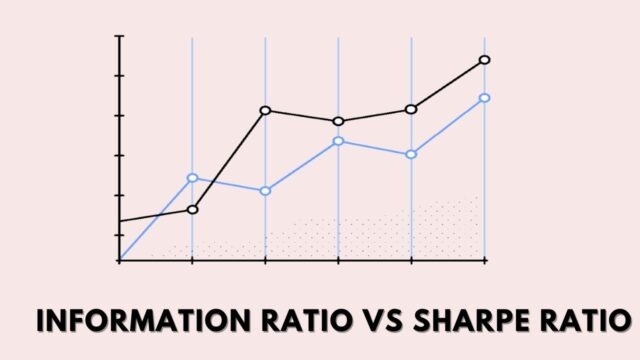
There are a number of different ratios that investors use to measure the performance of their investments. Two of the most popular ratios are the information ratio and the Sharpe Ratio. In this article, we will compare and contrast these two measures, and discuss which one is better for evaluating investment performance.
What is the Information Ratio (IR)?
The information ratio (IR) is a measure of the risk-adjusted return of an investment portfolio. It is calculated by dividing the portfolio’s excess return over a risk-free rate by its standard deviation of returns. The higher the IR, the more return the portfolio has generated per unit of risk. A portfolio with a high IR is said to be “information rich,” meaning that it has generated a lot of return for the amount of risk taken.
In general, investors seek to maximize their IR in order to maximize their risk-adjusted return. However, it is important to note that a high IR does not necessarily mean that an investment is a good one; it simply means that the investment has been profitable relative to its level of risk. Therefore, investors must always perform due diligence before investing in any security.
What is the Sharpe Ratio (SR)?
The Sharpe ratio is a risk-adjusted performance measure that has been developed by Nobel laureate William F. Sharpe. It is used to help investors understand whether the returns on an investment are due to market conditions or higher risk.
The Sharpe ratio is calculated by subtracting the risk-free rate of return from the portfolio’s return and then dividing the result by the standard deviation of the portfolio’s returns. A higher Sharpe ratio indicates that the portfolio’s returns are due to market conditions rather than higher risk. The Sharpe ratio is a valuable tool for assessing whether an investment is likely to be profitable in the long term.
How are IR and SR calculated?
Investors often use risk-adjusted performance measures to evaluate how a portfolio has performed. Two of the most common measures are the Information Ratio (IR) and the Sharpe Ratio (SR). Both ratios compare the return of a portfolio to a benchmark, but they do so in different ways.
The Information Ratio is calculated as the excess return of the portfolio over the benchmark, divided by the tracking error. The tracking error is a measure of how much volatility there is in the relationship between the return of the portfolio and the return of the benchmark. A higher Information Ratio indicates that a portfolio has generated more return per unit of risk.
The Sharpe Ratio is calculated as the excess return of the portfolio over the risk-free rate, divided by the standard deviation of returns. TheSharpe Ratio measures how much excess return a portfolio has generated per unit of market risk. A higher Sharpe Ratio indicates that a portfolio has generated more return per unit of risk.
Both ratios can be used to evaluate past performance and to make decisions about future investments. However, it is important to keep in mind that both ratios have limitations. For example, the Information Ratio does not account for cash flows, and theSharpe Ratio does not account for liquidity.
Which measure is better for evaluating investments – IR or SR?
Generally, higher values for either ratio indicate a better investment. However, there are some limitations to these measures. For instance, IR only considers downside risk, while SR only considers volatility. In addition, both ratios can be sensitive to outliers and can be influenced by the choice of benchmarks.
Despite these limitations, IR and SR are still useful measures for evaluating investments. Comparing the two ratios can give insights into the risk and return characteristics of an investment. Ultimately, whether or not an investment is a good choice depends on the investor’s objectives and risk tolerance.
How can you use IR and SR to make investment decisions?
When it comes to making investment decisions, many factors must be considered. One important consideration is the risk-reward profile of a potential investment. This can be evaluated using two key metrics: the Information Ratio (IR) and the Sharpe Ratio (SR).
The Information Ratio measures the excess return of an investment relative to its benchmark. The higher the Information Ratio, the better the investment’s performance. The Sharpe Ratio, on the other hand, measures risk-adjusted returns. It takes into account the volatility of an investment’s returns and compares them to a risk-free rate of return. A higher Sharpe Ratio indicates that an investment has generated higher returns relative to its level of risk.
Both the Information Ratio and Sharpe Ratio can be useful in making investment decisions. However, it’s important to remember that they measure different things. The Information Ratio focuses on absolute performance, while the Sharpe Ratio focuses on risk-adjusted performance. As a result, one metric may provide more insight than the other depending on the particular investment under consideration.
What are the limitations of each ratio?
Information ratio is a popular risk adjusted performance measure used by portfolio managers to evaluate their performance. Information ratio is the ratio of excess return over and above the risk free return to the volatility of the excess return. Information ratio will be high when the portfolio manager is able to generate higher returns for the same amount of risk or lower risk for the same return.
Sharpe ratio, on the other hand, is the ratio of excess return over and above the risk free return to the overall volatility of the portfolio. In order to enhance Sharpe ratio, a portfolio manager can either increase excess return or decrease volatility. However, what a portfolio manager should really aim for is to find an optimal combination of both.
With that being said, Information ratio has its own limitations. Information ratio fails to take into account diversifiable risks which are specific to individual securities in a portfolio and can be eliminated by holding such securities in a diversified manner. Information ratio also doesn’t account for required returns which may differ from investor to investor. Lastly, Information ratio doesn’t factor in transaction costs that are associated with buying and selling securities within a portfolio.
Conclusion
The Information Ratio (IR) is a risk-adjusted measure of return that is used to evaluate investment performance. Sharpe ratio, on the other hand, is a risk-adjusted measure of return that takes into account the variability of returns. Both ratios are useful in evaluating investment performance, but they have different strengths and weaknesses.
Sharpe ratio is a better measure of risk-adjusted return when returns are very volatile. This is because the Sharpe ratio takes into account the variability of returns, while the Information Ratio does not. However, Information Ratio is a better measure of risk-adjusted return when returns are not very volatile. This is because the Information Ratio only looks at the average return, while the Sharpe ratio looks at the variability of returns.
Both ratios are useful in evaluating investment performance, but they have different strengths and weaknesses. Which ratio you use will depend on your investment goals and objectives.

































